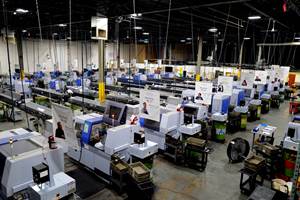Yet Another VMC—Why Not?
With so many vertical machining centers on the market, why would a major machine tool builder introduce yet another entry into this highly competitive environment? The only logical answer can be that this builder believes no one else is producing a machine that compellingly fills an existing need.
Share






With so many vertical machining centers on the market, why would a major machine tool builder introduce yet another entry into this highly competitive environment? The only logical answer can be that this builder believes no one else is producing a machine that compellingly fills an existing need. Hence comes the NV5000 from Mori Seiki.
The new machine is targeted to the standard 40-taper VMC market. Although Mori Seiki is best known for high-end horizontal machining centers and lathes, the company has sought to improve its share of the VMC market in recent years. Knowing that many of the 40-taper machine buyers do spread-sheet comparisons of specs and capabilities, Mori Seiki developers also looked at this spreadsheet and set out to design a machine that would beat, category by category, the ratings of similar machines.
According to the company, the machine was designed and engineered from the ground up, using computer-aided design and finite element analysis. This project was conducted by Mori Seiki's own design team at Digital Technology Laboratory, its research and development facility in Sacramento, California. These analytical methods indicated the optimal bed thickness, rib shape and rib position to maximize stiffness without adding weight. This effort helped the company improve the performance of the machine while simultaneously reducing the initial development cost.
The X-, Y-, and Z-axis travels are 31.5 by 20.1 by 20.1 inches, more than adequate for the work that typically travels across machines of this class. However, most machines with a comparable workzone take up more floor space, the company points out. The worktable is close to the front of the machine so the operator has less reaching to work inside the machine. The enclosure covers the sides and top to keep chips and coolant splash contained, yet doors have top panels so that, when opened, workpieces can be loaded by overhead crane.
In operation, speed is a major consideration. This VMC features a top spindle speed of 12,000 rpm, compared to the 7,000 rpm and 10,000 rpm typically found on machines the company includes in this class. The spindle uses direct drive gearless technology and provides acceleration to full speed in 0.97 second. A 20,000-rpm spindle is available as an option. The top rapid traverse rate for all three axes is 1,654 ipm. In the automatic tool changer (ATC), tool-to-tool time is 1.0 second and chip-to-chip time is 2.6 seconds.
Accuracy is another major consideration. Here, the company points to features beyond built-in structural rigidity that minimize vibration, the chief factor that degrades accuracy in any machine in a high-speed application. Among these features is increased tool clamping power in the spindle, for example. Thermal growth in the spindle, which also affects accuracy, is addressed by an optional compensation function.
Design features include those to enhance maintainability in the field. To reduce the number of components in the ATC, the magazine has a direct drive rather than a gear train. To avoid a worn timing belt on the Z axis, it has been connected directly to the ballscrew. No electrical cables are located under the machine where they are difficult to check and repair. Lubricant distributors are located outside the machine where they are easy to reach. Other features are designed to reduce the environmental burden. Oil-free roller guides on the ways and an oil-bath ATC design reduce consumption of lubricants. Automatic power cut-off reduces electricity consumption.
The CNC panel uses MAPPS (Mori Advanced Programming Production System) as the interface. This interface is common among Mori Seiki machining centers and incorporates features requested by users from around the world, the builder says. Software options, such as CAPS-NET for remote process logging and CAPS-DSN for program transfer, provide connections to a factory Ethernet network.
The company admits that the NV5000 has its strongest appeal to buyers looking for value (not the lowest price), but contends that the productivity potential of this machine makes a strong return on the investment a compelling selling factor.
Related Content
Inside the Premium Machine Shop Making Fasteners
AMPG can’t help but take risks — its management doesn’t know how to run machines. But these risks have enabled it to become a runaway success in its market.
Read MoreThe Future of High Feed Milling in Modern Manufacturing
Achieve higher metal removal rates and enhanced predictability with ISCAR’s advanced high-feed milling tools — optimized for today’s competitive global market.
Read More6 Machine Shop Essentials to Stay Competitive
If you want to streamline production and be competitive in the industry, you will need far more than a standard three-axis CNC mill or two-axis CNC lathe and a few measuring tools.
Read MoreHow to Determine the Currently Active Work Offset Number
Determining the currently active work offset number is practical when the program zero point is changing between workpieces in a production run.
Read MoreRead Next
AMRs Are Moving Into Manufacturing: 4 Considerations for Implementation
AMRs can provide a flexible, easy-to-use automation platform so long as manufacturers choose a suitable task and prepare their facilities.
Read MoreMachine Shop MBA
Making Chips and 91ÊÓƵÍøÕ¾ÎÛ are teaming up for a new podcast series called Machine Shop MBA—designed to help manufacturers measure their success against the industry’s best. Through the lens of the Top Shops benchmarking program, the series explores the KPIs that set high-performing shops apart, from machine utilization and first-pass yield to employee engagement and revenue per employee.
Read More



















